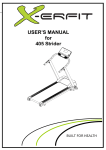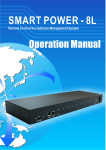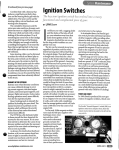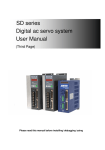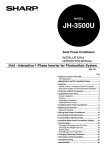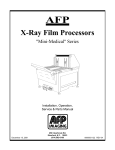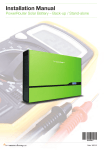Download Craftsman 172.117020 Operator`s manual
Transcript
Operator’s Manual 1/3 Sheet Pad Sander Model No. 172.117020 Double Insulated CAUTION: Read, understand and follow all Safety Rules and Operating Instructions in this manual before using this product. Sears Brands Management Corporation, Hoffman Estates, IL 60179 U.S.A. www.sears.com 3025736 • WARRANTY • SAFETY • UNPACKING • DESCRIPTION • ASSEMBLY • OPERATION • MAINTENANCE 6/4/12 TABLE OF CONTENTS SAFETY SYMBOLS Warranty……………………………...................................……………...Page Safety Symbols……………………………...................................……... Page Safety Instructions…………………………...................................……..Pages Unpacking.………………………………..................................……........Page Description............................................................................................Pages Assembly...............................................................................................Pages Operation..............................................................................................Pages Maintenance......................................................................................... Page Accessories...........................................................................................Page Parts List...............................................................................................Pages 2 3 4- 9 9 10-11 12-16 17- 20 21 22 23-24 CRAFTSMAN ONE YEAR LIMITED WARRANTY FOR ONE YEAR from the date of purchase, this product is warranted against any defects in material or workmanship. With proof of purchase, a defective product will be replaced free of charge. For warranty coverage details to obtain free replacement, visit the web site: www.craftsman.com This warranty does not cover the sanding sheets, which are expendable parts that can wear out from normal use within the warranty period. This warranty is void if this product is ever used while providing commercial services or if rented to another person. This warranty gives you specific legal rights, and you may also have other rights which vary from state to state. Sears Brands Management Corporation, Hoffman Estates, IL 60179 The purpose of safety symbols is to attract your attention to possible dangers. The safety symbols and the explanations with them deserve your careful attention and understanding. The symbol warnings do not, by themselves, eliminate any danger. The instructions and warnings they give are no substitutes for proper accident prevention measures. WARNING: Be sure to read and understand all safety instructions in this manual, including all safety alert symbols such as “DANGER,” “WARNING,” and “CAUTION” before using this pad sander. Failure to follow all instructions listed in this manual may result in electric shock, fire and/or serious personal injury. SYMBOL SIGNAL MEANING SAFETY ALERT SYMBOL: Indicates DANGER, WARNING, OR CAUTION. May be used in conjunction with other symbols or pictographs. DANGER: Indicates a hazardous situation which, if not avoided, will result in death or serious injury. This signal word is to be limited to the most extreme situations. Always follow the safety precautions to reduce the risk of fire, electric shock, and personal injury. WARNING: Indicates a hazardous situation which, if not avoided, could result in death or serious injury. Always follow the safety precautions to reduce the risk of fire, electric shock, and personal injury. CAUTION: Indicates a hazardous situation which, if not avoided, could result in minor or moderate injury. Damage Prevention and Information Messages These inform the user of important information and/or instructions that could lead to equipment or other property damage if they are not followed. Each message is preceded by the word “NOTE,” as in the example below: NOTE: Equipment and/or property damage may result if these instructions are not followed. WARNING: To ensure safety and reliability, all repairs should be performed by a qualified service technician. SAVE THESE INSTRUCTIONS! READ ALL INSTRUCTIONS! ! WARNING: Some dust created by using power tools contains chemicals known to the State of California to cause cancer and birth defects or other reproductive harm. 2 WARNING: The operation of any power tools can result in foreign objects being thrown into your eyes, which can result in severe eye damage. Before beginning power tool operation, always wear safety goggles or safety glasses with side shield and a full face shield when needed. We recommend a Wide Vision Safety Mask for use over eyeglasses or standard safety glasses with side shields. Always use eye protection which is marked to comply with ANSI Z87.1 shields. 3 SAFETY INSTRUCTIONS cont. SAFETY INSTRUCTIONS ! WARNING: Read all safety warnings and instructions. Failure to follow the warnings and instructions may result in electric shock, fire and/or serious injury. Save all warnings and instructions for future reference. The term power tool in the warnings refers to your electric (corded) power tool or battery-operated (cordless) power tool. WORK AREA SAFETY 1. Keep work area clean and well lit. Cluttered or dark areas invite accidents. 2. Do not operate power tools in explosive atmospheres, such as in the presence of flammable liquids, gases or dust. Power tools create sparks which may ignite the dust or fumes. 3. Keep children and bystanders away while operating a power tool. Distractions can cause you to lose control. 4. Make your workshop childproof with padlocks and master switches. Lock tools away when not in use. 5. MAKE SURE the work area has ample lighting so you can see the work and that there are no obstructions that will interfere with safe operation BEFORE using your power tool. PERSONAL SAFETY 1. Stay alert, watch what you are doing and use common sense when operating a power tool. Do not use a power tool while you are tired or under the influence of drugs, alcohol or medication. A moment of inattention while operating power tools may result in serious personal injury. 2. Use personal protective equipment. Always wear eye protection. Protective equipment such as dust mask, non-skid safety shoes, hard hat, or hearing protection used for appropriate conditions will reduce personal injuries. 3. Prevent unintentional starting. Ensure the switch is in the off-position before connecting to power source and/or battery pack, picking up or carrying the tool. Carrying power tools with your finger on the switch or energizing power tools that have the switch on invites accidents. 4. Remove any adjusting key or wrench before turning the power tool on. A wrench or a key left attached to a rotating part of the power tool may result in personal injury. 5. Do not overreach. Keep proper footing and balance at all times. This enables better control of the power tool in unexpected situations. 6. Dress properly. Do not wear loose clothing or jewelry. Keep your hair, clothing and gloves away from moving parts. Loose clothes, jewelry or long hair can be caught in moving parts. 7. If devices are provided for the connection of dust extraction and collection facilities, ensure these are connected and properly used. Use of dust collection can reduce dust-related hazards. 4 TOOL USE AND CARE SAFETY ! WARNING: BE SURE to read and understand all instructions before operating this power tool. Failure to follow all instructions listed below may result in electric shock, fire and/or serious personal injury. 1. Do not force the power tool. Use the correct power tool for your application. The correct power tool will do the job better and safer at the rate for which it was designed. 2. Do not use the power tool if the switch does not turn it on and off. Any power tool that cannot be controlled with the switch is dangerous and must be repaired. 3. Disconnect the plug from the power source and/or the battery pack from the power tool before making any adjustments, changing accessories, or storing power tools. Such preventive safety measures reduce the risk of starting the power tool accidentally. 4. Store idle power tools out of the reach of children and do not allow persons unfamiliar with the power tool or these instructions to operate the power tool. Power tools are dangerous in the hands of untrained users. 5. Maintain power tools. Check for misalignment or binding of moving parts, breakage of parts and any other condition that may affect the power tools operation. If damaged, have the power tool repaired before use. Many accidents are caused by poorly maintained power tools. 6. Keep cutting tools sharp and clean. Properly maintained cutting tools with sharp cutting edges are less likely to bind and are easier to control. 7. Use the power tool, accessories and tool bits etc., in accordance with these instructions and in the manner intended for the particular type of power tool, taking into account the working conditions and the work to be performed. Use of the power tool for operations different from those intended could result in a hazardous situation. 8. Use clamps or another practical way to secure and support the workpiece to a stable platform. 9. Holding the work by hand or against your body leaves it unstable and may lead to loss of control. ! WARNING: Empty dust bag before storage to help prevent possible fire hazard, especially when resin coating or linseed oil finishes have been sanded. ELECTRICAL SAFETY ! WARNING: Do not permit fingers to touch the terminals of plug when installing or removing the plug from the outlet. 1. Double insulated tools are equipped with a polarized plug (one blade is wider than the other). This plug will fit in a polarized outlet only one way. If the plug does not fit fully in the outlet, reverse the plug. If it still does not fit, contact a qualified electrician to install a polarized outlet. Do not change the plug in any way. 5 Cover of Grounded Outlet Box SAFETY INSTRUCTIONS cont. SAFETY INSTRUCTIONS cont. ELECTRICAL SAFETY ! WARNING: Do not permit fingers to touch the terminals of plug when installing or removing the plug from the outlet. 2. Power tool plugs must match the outlet. Never modify the plug in any way. Do not use any adapter plugs with grounded power tools. Unmodified plugs and matching outlets will reduce risk of electric shock. ! WARNING: Double insulation DOES NOT take the place of normal safety precautions when operating this tool. 3. Avoid body contact with grounded surfaces such as pipes, radiators, ranges and refrigerators. There is an increased risk of electric shock if your body is grounded. 4. Do not expose power tools to rain or wet conditions. Water entering a power tool will increase the risk of electric shock. 5. Do not abuse the cord. Never use the cord for carrying, pulling or unplugging the power tool. Keep cord away from heat, oil, sharp edges or moving parts. Damaged or entangled cords increase the risk of electric shock. 6. When operating a power tool outdoors, use an extension cord suitable for outdoor use marked “W-A” or “W”. Use of a cord suitable for outdoor use reduces the risk of electric shock. 7. If operating a power tool in a damp location is unavoidable, use a Ground Fault Circuit Interupter (GFCI) protected supply. Use of a GFCI reduces the risk of electric shock. EXTENSION CORDS USE PROPER EXTENSION CORD. Make sure your extension cord is in good condition. When using an extension cord, be sure to use one heavy enough to carry the current your product will draw. An undersized cord will cause a drop in line voltage resulting in loss of power and overheating. Table 1 shows the correct size to use depending on cord length and nameplate ampere rating. If in doubt, use the next heavier gage. The smaller the gage number, the heavier the cord. Table 1: Minimum Gage for Cord Rating Volts ! WARNING: Check extension cords before each use. If damaged replace immediately. Never use tool with a damaged cord since touching the damaged area could cause electrical shock, resulting in serious injury. SAFETY SYMBOLS FOR YOUR TOOL The label on your tool may include the following symbols. V.......................................................................Volts A...................................................................... Amps Hz.................................................................... Hertz W..................................................................... Watts min..................................................................Minutes ....................................................................Alternating current ...............................................................Direct current no ....................................................................No-load speed ....................................................................Class II construction, Double Insulated .../min.............................................................. Revolutions or Strokes per minute OPM.................................................................Orbits Per Minute ! ....................................................................Indicates danger, warning or caution. It means attention! Your safety is involved. SERVICE SAFETY 1. If any part of this tool is missing or should break, bend, or fail in any way; or should any electrical component fail to perform properly: SHUT OFF the power switch and remove the tool’s plug from the power source and have the missing, damaged or failed parts replaced BEFORE resuming operation. 2. Have your power tool serviced by a qualified repair person using only identical replacement parts. This will ensure that the safety of the power tool is maintained. 3. If the replacement of the supply cord is necessary, this has to be done by the manufacturer or his agent in order to avoid a safety hazard. SAFETY RULES FOR POWER SANDERS Total cord length (in feet) ! CAUTION: Keep the extension cord clear of the working area. Position the cord so that it will not get caught on lumber, tools or other obstructions while you are working with a power tool. 1. HOLD TOOL by insulated gripping surfaces when sanding where tool may contact hidden wiring, such as walls, floors, or its own power cord. Contact with a “live” wire will make exposed metals parts of the tool “live” and shock the operator. 2. INSPECT FOR AND REMOVE all nails, screws, staples or any embedded pieces of metal from surface to be sanded. These protrusions could damage the sandpaper, the cushion of the sander and cause loss of control. Following this rule will reduce the risk of serious personal injury and damage to the sander. 3. NEVER use this or any power sander for wet sanding or liquid polishing. Failure to follow this rule will increase the risk of electric shock. 4. ALWAYS clamp the workpiece securely so it will not move under the sander. Unsecured work could be thrown towards the operator, causing injury. 5. DO NOT force the sander. The weight of the sander supplies adequate pressure. Let the sander and the grit on the sandpaper do the work. 6. DO NOT sand in any one place for too long. The sander’s rapid action may remove too much material and make the surface uneven. 6 7 120V Ampere More Than 0 6 10 12 Not More Than 25 50 100 150 AWG 6 10 12 18 18 16 16 16 16 16 14 12 16 14 14 14 12 12 Not recommended SAFETY INSTRUCTIONS cont. ! WARNING: Some dust created by using power tools contains chemicals known to the State of California to cause cancer and birth defects or other reproductive harm. Some examples of these chemicals are: • Lead from lead-based paints. • Crystalline silica from bricks and cement and other masonry products. • Arsenic and chromium, from chemically treated lumber. Your risk from these exposures varies, depending upon how often you do this type of work. To reduce your exposure to these chemicals: • Work in a well-ventilated area. • Work with approved safety equipment, such as those dust masks that are specially designed to filter out microscopic particles. Avoid prolonged contact with dust from power sanding, sawing, grinding, drilling and other construction activities. Wear protective clothing and wash exposed areas with soap and water. Allowing dust to get into your mouth, eyes, or lay on the skin may promote absorption of harmful chemicals. ! WARNING: Use of this tool can generate and/or disburse dust, which may cause serious and permanent respiratory or other injury. Always use NIOSH/OSHA approved respiratory protection appropriate for the dust exposure. Direct particles away from face and body. ADDITIONAL RULES FOR SAFE OPERATION ! WARNING: BE SURE to read and understand all instructions. Failure to follow all instructions listed below may result in electric shock, fire and/or serious personal injury. 1. Harmful/toxic dusts will arise from sanding e.g. lead painted surfaces, woods and metals. Contact with or inhalation of these dusts can endanger the health of operator and bystanders. Always use eye glasses and dust mask. 2. Hearing protection should be worn when using the sander. 3. Always wear safety glasses or eye shields when using the sander. Everyday eyeglasses have only impact-resistant lenses; they are not safety glasses. Following this rule will reduce the risk of serious personal injury. 4. Remove the plug from the socket before carrying out any adjustment, servicing or maintenance. 5. Fully unwind cable drum extensions to avoid potential overheating. 6. When an extension cable is required you must ensure it has the correct ampere rating for your power tool and is in a safe electrical condition. 7. Ensure your mains supply voltage is same as indicated on the rating plate. 8. Your tool is double insulated for additional protection against a possible electrical insulation failure within the tool. 9. Always check walls, floors and ceilings to avoid hidden power cables and pipes. 10. After long working periods external metal parts and accessories could be hot. 11. If possible, ensure the work-piece is firmly clamped to prevent movement. 12. Your sander is a hand held tool, do not clamp your sander. 13. Before sanding, check the area is free of nails, screws, etc. 14. Never stop the sander by applying a force to the base plate. 15. Only use paper in good condition. Do not use torn or worn paper. 16. Do not sand material containing asbestos due to a health risk. 8 SAFETY INSTRUCTIONS cont. ADDITIONAL RULES FOR SAFE OPERATION cont. 17. 18. 19. 20. 21. 22. 23. 24. Do not sand lead based paint due to the risk of lead poisoning. Do not eat or drink in the working area of the sander. Do not allow people to enter the working area without wearing a dust mask. Where possible, seal off the working area to contain the dust for later removal. Your tool is designed for dry sanding only, not wet sanding. Your tool is designed for general purpose light polishing of wood and metals. Do not sand magnesium material due to the risk of fire. SAVE THESE INSTRUCTIONS. Refer to them frequently and use them to instruct others who may use this tool. If someone borrows this tool, make sure they have these instructions also. UNPACKING ! WARNING: This power tool should NEVER be connected to the power source when you are assembling parts, making adjustments, installing or removing sandpaper, cleaning or when it is not in use. Disconnecting the sander will prevent accidental starting, which could cause serious personal injury. 1. Remove the sander from the carton and inspect it carefully to make sure that no breakage or damage has occurred during shipping. 2. Do not discard any of the packing materials until all parts are accounted for. 3. Included with your sander is a dust bag assembly. 4. 3 sheets of sandpaper are included; one 80 grit, one 100 grit, and one 120 grit. 5. Also included is a paper punch template, and a vac adapter for hook-up to a wet /dry vac, sold separately. 6. If any of the parts are damaged or missing (refer to PARTS LIST below), return the sander to your nearest Sears store or Craftsman outlet to have the sander replaced. ! WARNING: If any parts are missing, DO NOT operate this power tool until the missing parts are replaced. Failure to do so could result in possible serious personal injury. PARTS LIST (Fig. 1) 1. Sander 2. Dust Bag Assembly (comes attached to sander) 3. Vac Adapter 4. Three Sanding Sheets 6. Storage/ Carrying Case 7. Operator’s Manual 5. Paper Punch Template 9 DESCRIPTION DESCRIPTION cont. KNOW YOUR PAD SANDER (Fig. 2) This Pad Sander has the following features cont.: 12. Vac adapter allows hook-up to wet/dry vac (sold separately) NOTE: Before attempting to use your sander, familiarize yourself with all of the operating features and safety requirements. Your 1/3-sheet pad sander has a precision-built electric motor and it should be connected to a 120-volt, 60-Hz AC ONLY power supply (normal household current). DO NOT operate on direct current (DC). The large voltage drop will cause a loss of power and the motor will overheat. If the sander does not operate when plugged into correct 120-volt, 60-Hz AC ONLY outlet, check the power supply. This sander has a 8-ft., 2-wire power cord (no adapter needed). 13. High impact-resistant housing helps protect tool from damage and reduces weight 14. Permanently lubricated 100% ball bearings for smooth operation and long life. 15. Storage /Carrying Case for easy carrying and storage of sander and accessories. On / Off Slide Switch Fig 2 This Pad Sander has the following features: 1. Powerful 2.0 amp motor provides the torque, power and durability for a variety of continuous sanding applications. 2. 12,000 orbits per minute with 1/16-in. orbit diameter matched with the correct sandpaper grit for the surface being sanded provides fast material removal and/or a fine, smooth finish. 3. Ergonomically designed rear handle and front assist handle with molded-in comfort grip for maximum balance, control and gripping comfort. Rear Handle Front Assist Handle Live Tool Indicator green LED light Paper Clamp Dust Bag Assembly 4. Precision-tuned counterbalanced system reduces vibration for smooth operation and less operator fatigue. Platen 5. On/Off slide switch is conveniently located for easy control. Sealed to keep out dust for long life. Lock-on for continuous sanding. 6. Live Tool Indicator green LED light comes on when sander is plugged into a power outlet. Platen Slot Sandpaper 7. Die-cast aluminum sanding base stands up to heavy-duty use. 8. Two paper clamps, one located at the front of the sander and the other at the back, provide secure paper retention and simple, fast paper changes. 9. The cushion located on the bottom of the sander accepts standard non-adhesive sandpaper. 10. Uses 1/3-sheet sandpaper to provide a 25-sq. in. sanding surface. 3 sandpaper sheets included (80, 100 and 120 grit). 11. Built-in dust collection system with removable dust bag assembly. This system collects dust from work surface through the 10 holes located in the platen and cushion on the bottom of the sander. A paper punch template is included for accurately punching holes in the 1/3-sheet sandpaper. 10 Paper Clamp Lever PRODUCT SPECIFICATIONS No-load Speed 12,000 OPM (Orbits Per Minute) Rating 120 Volts, 60 Hz AC Input 2.0 Amps Orbit Diameter 1/16 in. Paper Size 1/3 Sheet Paper Type Non-Adhesive Sandpaper 11 Cushion ASSEMBLY cont. ASSEMBLY ! WARNING: Your sander should NEVER be connected to the power source when you are assembling parts, making adjustments, installing or removing sandpaper, cleaning or when it is not in use. Disconnecting the sander will prevent accidental starting, that could cause serious personal injury. INSTALLING THE SANDPAPER (See Figs. 3, 3a, 3b and 4) This sander has a cushion that allows you to use non-adhesive sandpaper. The nonadhesive sandpaper clamps to the front and back of the platen and cushion. Installing Non-Adhesive Sandpaper (See Figs. 3 , 3a and 3b) NOTE: Remove dust bag assembly when installing non-adhesive paper. ALWAYS remember to reattach the dust bag assembly before beginning sanding operation (see pages 16, Fig. 6). Fig 3b Fig 3a This sander has a dust collection system that collects dust from the worksurface through 10 holes located in the platen and cushion on the bottom of the sander. A paper punch template is included for accurately punching holes into the 1/3-sheet sandpaper. NOTE: Holes must be punched into the paper for the dust collection system to work properly. See instructions on page 14 to punch holes. Clamp Move lever down to raise clamp Paper Goes Under Clamp Raise lever up to clamp paper 2. If replacing sandpaper, remove old sandpaper. Installing Non-Adhesive Sandpaper (See Figs. 3, 3a and 3b) 3. Two paper clamp levers are located on each side of the sander and are locked into a slot on top of the platen (see Fig. 3). Fig 3 4. Raise these two levers “UP” and disengage them from the slots in the platen. This will release the tension on the paper clamps located at the front and back of the sander that hold the paper in position on the cushion (see Fig. 3a). Paper Clamp Paper Goes Under Clamp Paper Clamp Paper Goes Under Clamp Cushion Platen Non-Adhesive Sandpaper Platen Slot Paper Clamp Lever ALWAYS inspect the sandpaper before installing. DO NOT use if broken or defective. 1. Unplug the sander. ! WARNING: Failure to unplug the sander could result in accidental starting causing possible serious personal injury. 12 5. Remove old paper. 6. Insert front end of a new sheet of paper approximately 1/2-inch under the front paper clamp (see Fig. 3b). 7. Lift up on the lever that controls the front paper clamp and lock it back into the slot on the platen. This will securely clamp the paper to the front of the sander’s cushion. 8. Smooth out the sheet of paper by pressing it tightly against the bottom of the cushion (front to back). 9. Insert back end of paper approximately 1/2-inch under the paper clamp located at the back of the sander. 10. Lift up on the lever that controls the paper clamp located at the back of the sander and lock it back into the slot on the platen. This will securely clamp the paper to the back of the sander’s cushion. The sandpaper should now be positioned tightly against the cushion from front to back, securely clamped in place. NOTE: ALWAYS be sure that both paper clamp levers are in the locked position on the platen and both paper clamps have the sandpaper securely clamped to the bottom of the cushion before starting sanding operation. NOTE: Never use the sander without paper attached to the cushion. This will cause damage to the cushion. 13 ASSEMBLY cont. ASSEMBLY cont. PAPER PUNCH (See Figure 4) A paper punch template is included with sander so you can punch properly aligned holes into the sandpaper. This is done after the paper is installed onto the sander. To punch holes, line up the front and side of the sander over the paper punch template as shown in Fig. 4, then lower the sander onto the template while applying pressure. Make sure the holes are punched all the way through the paper and clear the holes in the sander’s cushion and platen. NOTE: Punching holes properly is a necessary step for the dust collection system to operate properly. TO REMOVE AND EMPTY DUST BAG cont. (See Fig. 5) 3. Remove the dust bag / wire adapter from the dust bag assembly by sliding it down and out of the slots in the assembly (see Fig. 5a). 4. Remove the bag from the wire frame and shake aggressively to completely empty the bag. (see Fig. 5b) Fig 5 Dust Bag Assembly Fig 4 Dust Exhaust Hole Adapter Dust Bag Fig 5b Fig 5a Orient Paper Punch as shown TO REMOVE AND EMPTY DUST BAG (See Fig. 5, page 15) 1. Unplug the sander. ! WARNING: Failure to unplug the sander could result in accidental starting causing possible serious personal injury. 2. Remove dust bag assembly from the sander by pulling it straight back and out of the sander (see Fig. 5, page 15). 14 5. When the bag is empty attach bag back onto the wire frame adapter (see Fig. 5b). Make sure the bag is fastened up to, and tightly around, the adapter. 6. Slide dust bag / wire adapter up into the slots on the dust bag assembly (see Fig. 5a) until they snap into position. 7. Attach dust bag assembly back into the sander. 8. Your sander is now ready to use. NOTE: Empty dust bag frequently when sanding so dust collection system works properly 15 ASSEMBLY cont. ! OPERATION WARNING: Empty dust bag before storage to help prevent possible fire hazard, especially when resin coating or linseed oil finishes have been sanded. NOTE: For more efficient operation, we recommend that you empty the dust bag when it is no more than half full. This will allow the air to flow through the bag better. ALWAYS empty and clean the dust bag thoroughly when you've finished sanding and before you store the sander. ATTACHING THE VAC HOSE ADAPTER (See Fig. 6) Your sander includes a vac hose adapter that easily attaches to the sander. The adapter allows you to hook your sander up to your wet/dry vac (sold separately). 1. Unplug the sander. ! WARNING: Failure to unplug the sander could result in accidental starting causing possible serious personal injury. 2. Remove dust bag assembly from the sander by firmly holding the dust bag assembly and pulling it straight out. 3. Insert vac hose adapter into the dust exhaust hole. 4. Push in adapter until the raised edges on the top and bottom of the adapter snap into the grooves in the dust exhaust hole. 5. Firmly attach the vac hose adapter to your vac hose. 6. Attach vac hose to your wet/dry vac. Before attempting to use any tool, be sure to familiarize yourself with all the operating features and safety instructions. ! WARNING: IF ANY PARTS ARE MISSING, DO NOT OPERATE YOUR SANDER UNTIL THE MISSING PARTS ARE REPLACED. FAILURE TO FOLLOW THIS RULE COULD RESULT IN SERIOUS PERSONAL INJURY. ! WARNING: DO NOT let familiarity with your sander make you careless. Remember that a careless fraction of a second is sufficient to cause severe injury. ON/OFF SLIDE SWITCH This switch is conveniently located on the top, front of the rear handle. Start the sander by sliding the switch forward to the On position and letting the motor build to its maximum speed before starting sanding operation. APPLICATIONS Only use your sander for the applications listed below. • Sanding wood surfaces with various grits of sandpaper. • Removing rust from steel surfaces with special sandpaper. ! CAUTION: ALWAYS be careful not to let your hand cover the air vents. ! WARNING: Unsecured work could be thrown towards the operator causing injury. Fig 7 Fig 6 Dust Exhaust Hole Vac Hose Adapter 16 17 OPERATION cont. OPERATION cont. USING YOUR SANDER (See Fig. 7) 1. 2. 3. 4. 5. ALWAYS clamp and secure the workpiece to prevent it from moving under sander. ALWAYS hold your sander in front and away from you, keeping it clear of the workpiece. Start the sander and let the motor build to its maximum speed. Gradually lower the sander onto the workpiece with a slight forward movement. Move the sander slowly, guiding it in a forward and backward motion. SANDING TIPS 1. DO NOT force the sander. The weight of the sander supplies adequate pressure on the workpiece. Let the sander and the sandpaper’s grit do the work. • Applying additional pressure will only slow down the motor, wear the sandpaper out faster and reduce the sander’s orbital speed. • Excessive pressure will overload the motor and cause possible damage to the sander from the motor overheating. • Excessive pressure will also result in a poor quality finish. 2. Any existing finish or resin on wood may soften from the heat of the friction and cause the sandpaper to load-up faster. 3. Inspect sandpaper frequently and change paper when grit is worn and not able to perform properly. 4. DO NOT sand in one spot for too long a time because the sander’s rapid action may remove too much material and make the surface uneven. NOTE: ALWAYS continue sanding with each grit until the surface is uniform. NOTE: DO NOT use the sander without sandpaper. This will damage the cushion. ! WARNING:DO NOT wear loose clothing or jewelry when operating sander. They could get caught in moving parts, causing serious injury. Keep head away from sander and sanding area. Hair could be drawn into sander, causing serious injury. ! WARNING:Empty dust bag before storage to help prevent possible fire hazard, especially when resin coating or linseed oil finishes have been sanded. NOTE: Empty dust bag frequently when sanding so dust collection system works properly. ORBITAL MOTION (See Fig. 8) As shown in Figure 8, the orbit of the sander is 1/16-inch in diameter so the sandpaper moves in tiny circles at high speed. SELECTING THE RIGHT SANDPAPER Selecting the correct grit and type of sandpaper is an extremely important decision that will allow you to achieve the best quality sanding finish. 1. Aluminum oxide, silicon carbide and other synthetic abrasives are best for power sanding. 2. Natural abrasives such as flint and garnet are too soft for economical use in power sanding. 3. Coarse grit will remove the most material and finer grit will give you the best finish in all sanding operations. 4. The condition of the surface to be sanded will determine which grit will do the job. 5. If the surface is rough: A. Start with a coarse grit and sand until the surface is uniform. B. Then use medium to remove any scratches left by the coarse grit. C. Then use a finer grit for finishing the surface. This orbital action duplicates a “hand sanding” motion for more aggressive sanding as you push the sander forward. This powerful orbital action is ideal for heavy-duty sanding applications, such as: 1. Removing old finishes 2. Smoothing rough wood 3. Sanding stock down to required dimensions 4. Finishing surfaces that are to be painted Fig 8 1/16-in Orbital Diameter 18 19 24 MODEL NUMBER 172.117020 1/3 Sheet Pad Sander 1 2 3 4 5 6 7 8 9 10 11 12 13 14 15 16 17 18 19 20 21 Item No. PFS220BU-1 PFS220BU-2 PFS220BU-3 PFS220BU-4 PFS220BU-5 PFS220BU-6 PFS220BU-7 PFS220BU-8 PFS220BU-9 PFS220BU-10 PFS220BU-11 PFS220BU-12 PFS220BU-13 PFS220BU-14 PFS220BU-15 PFS220BU-16 PFS220BU-17 PFS220BU-18 PFS220BU-19 PFS220BU-20 PFS220BU-21 Parts No. Power plug and cord Cord protector Cable clamp Connection pole Switch Slider switch pole Carbon brush Bearing Pin Screw Led Inner wire Insert Insert sleeve Inner wire Rotor Bearing Stator Aluminium fan Bearing Flitter support Part Description 1 1 1 1 1 1 2 1 4 2 1 1 2 2 1 1 1 1 1 1 2 Qty. 22 23 24 25 26 27 28 29 30 31 32 33 34 35 36 37 38 39 40 41 42 Item No. Part Description Screw Washer Paper clamp Base plate Aluminium plate Sponge plate Washer Spring washer Screw Right housing Screw Screw Dust bag support Steel wire support Steel wire support Dust bag cover Screw Dust bag Left housing Screw felt ring Parts No. PFS220BU-22 PFS220BU-23 PFS220BU-24 PFS220BU-25 PFS220BU-26 PFS220BU-27 PFS220BU-28 PFS220BU-29 PFS220BU-30 PFS220BU-31 PFS220BU-32 PFS220BU-33 PFS220BU-34 PFS220BU-35 PFS220BU-36 PFS220BU-37 PFS220BU-38 PFS220BU-39 PFS220BU-40 PFS220BU-41 PFS220BU-42 The model number will be found on the nameplate of the pad sander. Always mention the model number in all correspondence regarding your tool. PARTS LIST cont. 2 2 2 1 1 1 1 1 1 1 15 1 1 1 1 1 4 1 1 10 1 Qty.













